(American River, Sacramento County)
Species / Location
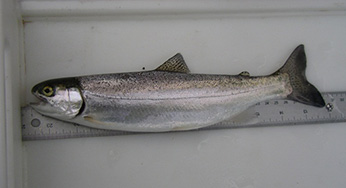
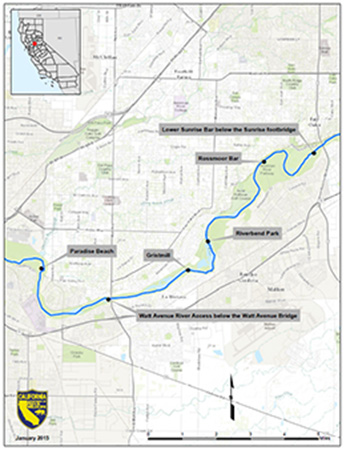 Figure 4. Map of the monitoring locations on the lower American River. (click/tap to enlarge)
Figure 4. Map of the monitoring locations on the lower American River. (click/tap to enlarge)
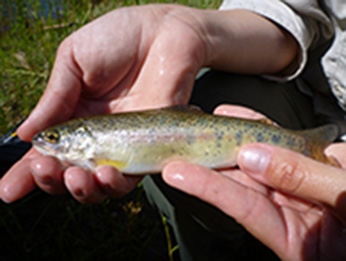 Figure 1. Juvenile steelhead from the lower American River.
Figure 1. Juvenile steelhead from the lower American River.
The American River is the second largest tributary to the Sacramento River in California’s Central Valley. Nimbus Dam, which regulates flow on the lower American River, marks the upstream limit to anadromy at river mile 23. Nimbus Fish Hatchery is located just downstream of Nimbus Dam, and produces Chinook salmon (Oncorhynchus tshawytscha) and steelhead (O. mykiss). River morphology downstream from the dam consists of alternating bar-complex and flat-water areas, with juvenile steelhead (Figure 1) strongly associated with the bar-complex riffle and run sequences. Average monthly flow on the lower American River is generally lowest in October and highest in May, based on long-term hydrological data. The lower American River is located in the Sacramento Valley bioregion of California, where a Mediterranean climate prevails and river temperature is relatively moderate in winter but high in summer for steelhead, which require cool water. While the river continues to support naturally spawning populations of steelhead and Chinook salmon, the large fish community (up to 28 species observed) is dominated in numbers of species by introduced warm-water fishes, reflecting a productive, lowland aquatic environment.
Steelhead support a very important fishery in California’s Central Valley, especially within the American River, which supports roughly 50% of angling effort for this species in the Sacramento River system. Because the Central Valley stock of steelhead is listed as threatened under the federal Endangered Species Act (ESA), special regulations are required to protect naturally produced or “wild” Central Valley steelhead. Such regulations include barbless hooks in certain reaches of streams, bag limits for hatchery-produced steelhead or rainbow trout (hatchery origin indicated by the absence of an adipose fin), and a catch-and-release fishery for wild steelhead.
Other proposed non-angling regulations include establishing minimum flow and temperature requirements for the lower American River. Establishing flow and water temperature criteria is critical for salmonid life-history needs as well as the economic quality of the fishery. The Sacramento Area Water Forum has formulated a Flow Management Standard (FMS) for the American River. The results were based on collaborative investigations and discussions between the California Department of Fish and Wildlife (CDFW), United States Fish and Wildlife Service, National Marine Fisheries Service, US Bureau of Reclamation representatives, and consultants. An agreed upon criterion of no more than 65°F mean daily water temperature along with adequate flows (2,000-2,500 cfs), with the exception of unusually dry water years, would be established with formal adoption of the FMS by State Water Resources Control Board SWRCB. To date, these more protective flow and temperature criteria have not been incorporated into a modification of the Bureau’s water right permit, but they are included in the Long-Term Operational Criteria and Plan for coordination of the Central Valley Project and State Water Project.
Need for Drought Stressor Monitoring
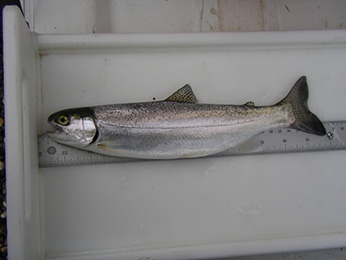 Figure 2. Natural-origin steelhead smolt on the lower American River at age 1.
Figure 2. Natural-origin steelhead smolt on the lower American River at age 1.
With 2014 being the third consecutive drought year for California, and a subsequent classification as a severe drought, there was concern for the fate of juvenile steelhead on the lower American River. Minimal rainfall, low runoff, extremely low reservoir carryover storage in Folsom Lake, and low river flows on the American River resulted in reduction of flows on the lower American River to 500 cfs. In a normal water year, the coldwater pool in Folsom Reservoir is typically greatly reduced by late summer due to water contract deliveries to the San Joaquin Valley and to meet SWRCB-mandated water quality standards in the Sacramento-San Joaquin Delta.
Water temperatures on the lower American River often exceed 70°F for several days to weeks at a time during late summer months. These high water temperatures promote the growth of bacteria, fungi, and parasites, which are common in such environments, and infect coldwater fishes such as steelhead at disease levels. Because of these factors, late summer conditions are typically a survival bottleneck for juvenile steelhead rearing in the lower American River. Despite all of the challenges that lower American River steelhead face in their first year, this population maintains one of the fastest growth rates seen in the Central Valley. Work to date by CDFW demonstrates that American River steelhead are highly anadromous, smolt at age 1+, and exceed growth rates of 1 mm per day (Figure 2). High growth rates likely enhance the survivability (to return to the river as adults) of steelhead in the lower American River.
Stressor Monitoring Efforts
The purpose of this work was to monitor the relative abundance, growth, condition, health, and survival of juvenile steelhead on the lower American River in response to drought-induced low-flow conditions. We predicted that we would observe a relatively high frequency of lower intestinal bacterial disease (rosy anus) if water temperatures were at a daily mean of 65°F or higher over a protracted period. The chosen steelhead sampling method was beach seining.
CDFW seined on a monthly basis at six locations in the lower American River from May of 2014 through the end of October 2014: Lower Sunrise Bar below the Sunrise footbridge, Rossmoor Bar, Riverbend Park, Gristmill, Watt Avenue River Access below the Watt Avenue Bridge, and Paradise Beach. These six sites were selected based on the following attributes: they were sampled historically; they were known juvenile steelhead rearing areas for which steelhead demonstrate a preference and fidelity; and they were easily accessible by samplers. Sampling efforts began around twilight to match the activity period of steelhead, to avoid detection of samplers by the fish, and to maximize catch-per-unit-effort of seining.
Beach seines (50 feet and 75 feet long) (Figure 3) were used to capture juvenile steelhead at each site, one site per evening. Generally two to six seine hauls were completed through each site. All captured steelhead were anesthetized, weighed and measured, and had origin determined by presence or absence of an adipose fin (hatchery steelhead have a clipped adipose fin). Passive Integrated Transponder (PIT) tags were given to steelhead measuring over 85 mm in length as biologists were hopeful of recapturing these fish to determine the site fidelity and growth rates of individuals over time. All fish were additionally examined for general condition and health. A fish would be considered “unhealthy” if it was missing fins, an eye, was discolored, undernourished, or had a prolapse of the anal connective tissues called “rosy anus” (Figure 4). In addition to fish data, habitat data such as area sampled and water temperature were recorded.
During May-June 2014, after this monitoring study had already begun, an emergency release of juvenile steelhead was made to the lower American River from Nimbus Fish Hatchery. This release was made in response to concerns about anticipated high water temperatures at the hatchery due to drought-induced low-flow conditions. These approximately 430,000 steelhead were released 7-8 months earlier and at a much smaller size than is normal for steelhead produced at Central Valley hatcheries. The steelhead in this emergency release were given a left pelvic fin clip, in addition to the typical adipose fin clip, to allow for identification of fish from this particular release in the future. It is anticipated that survival of this particular release group may be relatively low given small fish size and unfavorable flow and temperature conditions at release. Data collection included whether or not captured steelhead had the left pelvic fin clip, and were thus from this special release group.
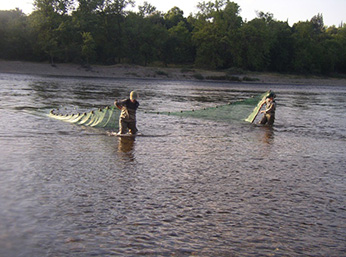 Figure 3. Beach seining for juvenile steelhead at Lower Sunrise Bar on the lower American River.
Figure 3. Beach seining for juvenile steelhead at Lower Sunrise Bar on the lower American River.
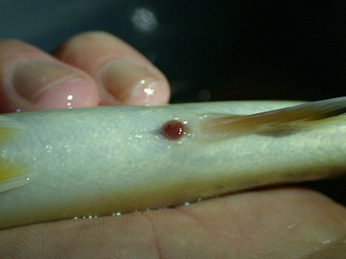 Figure 5. Juvenile steelhead exhibiting a prolapse of the anal connective tissue. This is the result of a lower intestinal bacterial disease called “rosy anus.” Depicted is an early stage of rosy anus.
Figure 5. Juvenile steelhead exhibiting a prolapse of the anal connective tissue. This is the result of a lower intestinal bacterial disease called “rosy anus.” Depicted is an early stage of rosy anus.
Findings
Between May and October of 2014, 453 juvenile steelhead were caught with a seine on the lower American River. Of those 453 steelhead, 83 (18%) were of natural origin while the remaining 370 (82%) were of hatchery origin. A sub-sample of the daily catch was tagged with a PIT tag and the catch on each subsequent sampling occasion was examined for recaptured fish. Fourteen juvenile steelhead of natural origin received a PIT tag and one was recaptured 26 days after it had been first captured. The growth rate for this particular fish was 1.38 millimeters per day, which is very high for the species. Fifty-nine hatchery origin steelhead received PIT tags, and three were recaptured. These three fish had an average growth rate of 1.23 millimeters per day.
Water temperatures on the lower American River were relatively high compared to previous years. The average monthly water temperature was 68°F during July through September with the highest water temperature observed (73°F) at lower Sunrise bar in mid-August. Despite the higher than average water temperatures, there were no visible signs of stress in the captured fish.
Future Efforts
We anticipate continuing the seining survey again in 2015, in collaboration with researchers at Sacramento State University, in an assessment of steelhead habitat restoration on the lower American River. The survey would begin in March of 2015 and conclude at the end of October 2015. The sampling methodology would remain the same, but with the hopes of tagging and recapturing more fish than in the previous year, and in a greater variety of rearing habitats, including restored and created side channels.